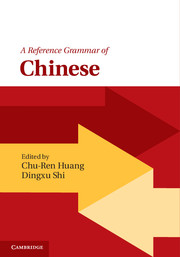Book contents
- Frontmatter
- Dedication
- Contents
- List of figures
- List of tables
- List of contributors
- Preface
- Acknowledgements
- English–Chinese term list
- Chinese–English term list
- 1 Preliminaries
- 2 Syntactic overview
- 3 Lexical word formation
- 4 Verbs and verb phrases
- 5 Aspectual system
- 6 Negation
- 7 Classifiers
- 8 Nouns and nominal phrases
- 9 Relative constructions
- 10 Adjectives and adjective phrases
- 11 Comparison
- 12 Adverbs
- 13 Prepositions and preposition phrases
- 14 Sentence types
- 15 Major non-canonical clause types: ba and bei
- 16 Deixis and anaphora
- 17 Information structure
- Appendix: Punctuation
- Bibliography
- Index
4 - Verbs and verb phrases
Published online by Cambridge University Press: 05 March 2016
- Frontmatter
- Dedication
- Contents
- List of figures
- List of tables
- List of contributors
- Preface
- Acknowledgements
- English–Chinese term list
- Chinese–English term list
- 1 Preliminaries
- 2 Syntactic overview
- 3 Lexical word formation
- 4 Verbs and verb phrases
- 5 Aspectual system
- 6 Negation
- 7 Classifiers
- 8 Nouns and nominal phrases
- 9 Relative constructions
- 10 Adjectives and adjective phrases
- 11 Comparison
- 12 Adverbs
- 13 Prepositions and preposition phrases
- 14 Sentence types
- 15 Major non-canonical clause types: ba and bei
- 16 Deixis and anaphora
- 17 Information structure
- Appendix: Punctuation
- Bibliography
- Index
Summary
Introduction
Clauses consist of subjects and predicates. Common instances of predicates are verb phrases, which are headed by verbs. Chinese verbs do not inflect for tense, person, gender, or number, but they can be immediately followed by aspect markers. The general lack of morphological clues has obscured the boundaries between verbs and other related lexical categories, such as adjectives, prepositions, and modal auxiliaries, in Chinese.
A verb phrase may be a simple structure with just a head verb or a complicated structure with the head verb and various dependent elements, such as arguments and modifiers. There are constraints on the number of elements appearing in the post-verbal position. Such constraints can be met by putting relevant elements into some other positions via topicalization, passivization, and verb reduplication, as well as by using the ba construction. In contrast, constraints on the types of elements that may appear in the post-verbal object position are less restrictive. Instrumental, temporal, and locative phrases, which typically appear as part of adverbial preposition phrases, may appear in the post-verbal object position under certain circumstances.
Summary of defining properties of verbs
Verbs can be suffixed with aspect markers 一 the perfective aspect marker 了 le0, the imperfective progressive/durative marker 着 zhe0, and the experiential marker 过 guo4 (see Chapter 5).
Some monosyllabic verbs can be reduplicated. The reduplicated forms can be Aa, A-yi-a with infix yi1 ‘one’ 一 or A-le-a.
A disyllabic verb AB can also be reduplicated. The reduplicated form is ABab.
Verbs can appear in the form of V-not-V to form alternative questions.
Verbs can serve as simple answers to both yes–no questions and some variable questions.
Verbs can be followed by objects.
Verbs can combine with other words to form compounds according to various types of morphological and syntactic principles.
Verbs can be classified into different subtypes according to the number and type of arguments they have.
Some emotion verbs and epistemic verbs are gradable in that they have relative degrees. They can enter comparison and can be modified by degree adverbials.
- Type
- Chapter
- Information
- A Reference Grammar of Chinese , pp. 81 - 115Publisher: Cambridge University PressPrint publication year: 2016

